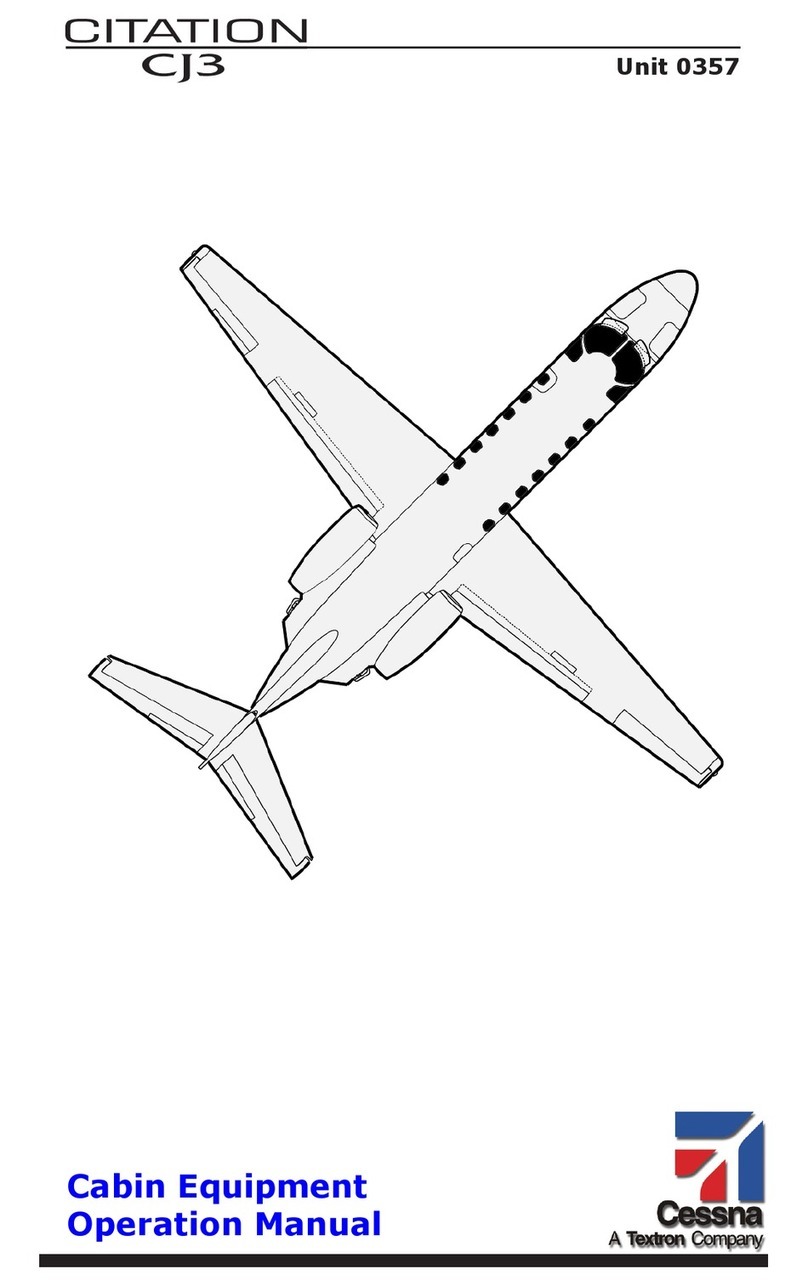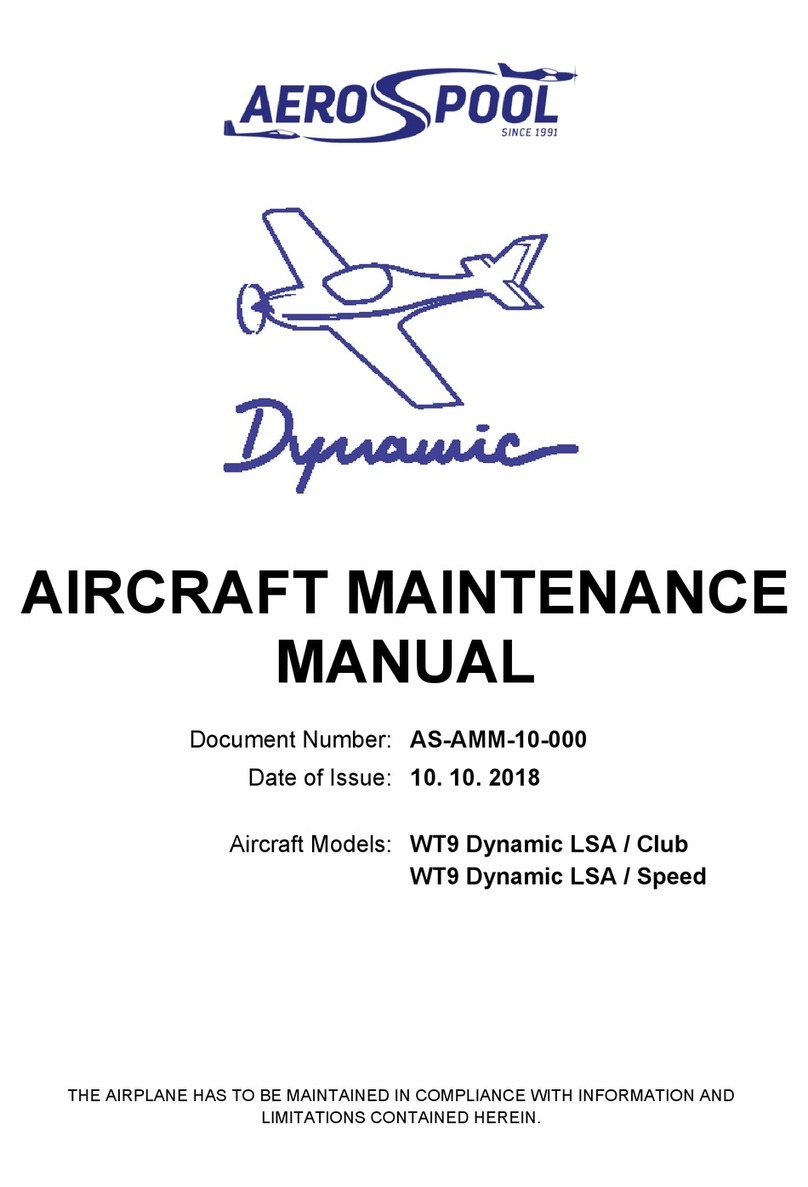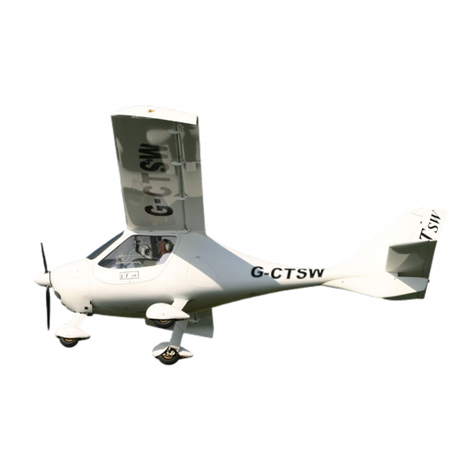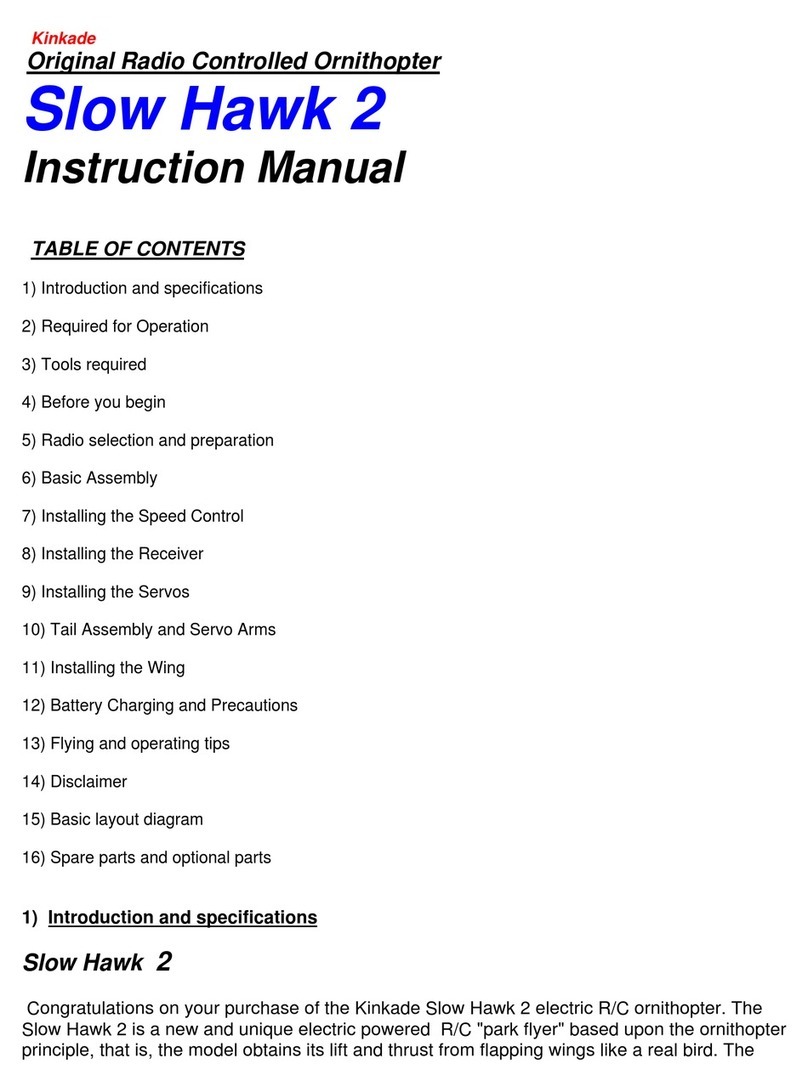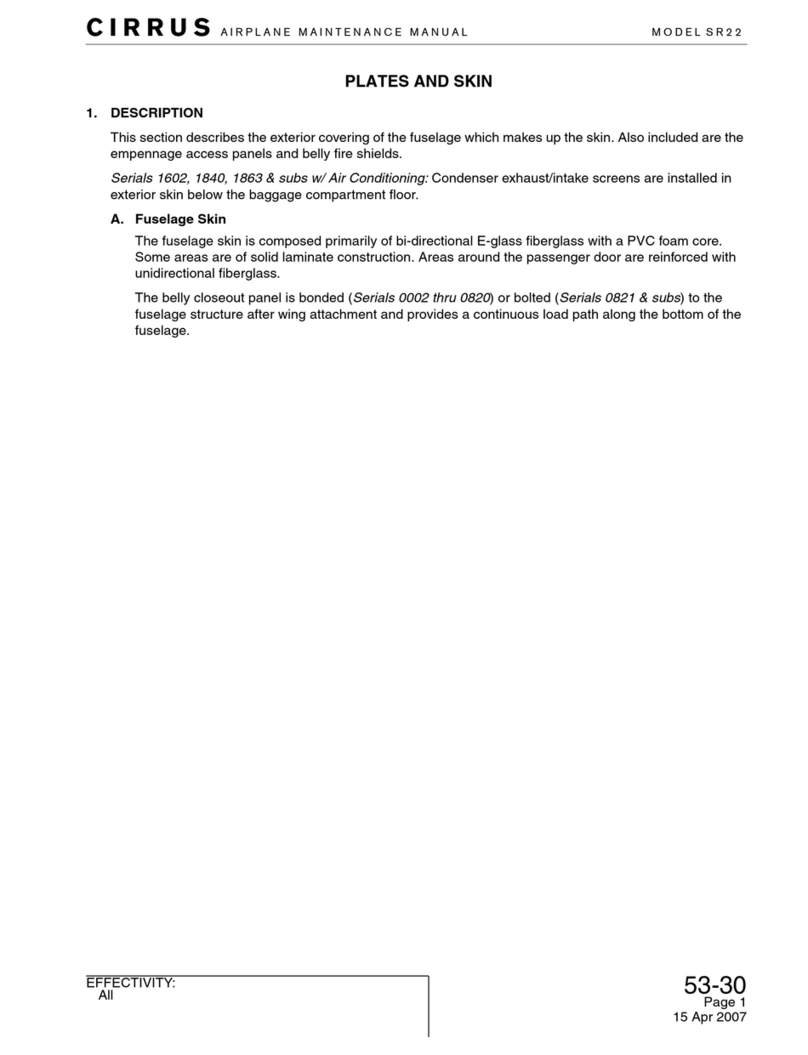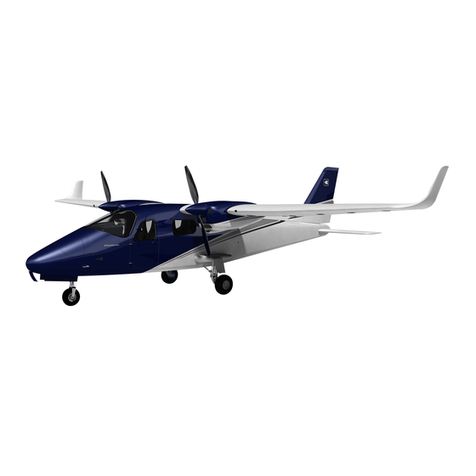Skyranger BMAA User manual

Skyranger Operators Manual
G_______ Serial No.: BMAA/HB/_ _ _
Approving Authority
British Microlight Aircraft Association
The Bullring, Deddington, Banbury
Oxon, OX15 0TT, United Kingdom
by delegation from the United Kingdom Civil Aviation Authority
Manufacturer
Design rights are owned by Best Off – France. Manufactured under licence by Aeros – Ukraine.
Importer
Aircraft Kits and Spares are imported by:
Skyranger UK Ltd
This manual is a legal document which is approved for use with Skyranger microlight aircraft issued
with a United Kingdom Homebuilt Permit to Fly. It must remain with the aircraft, and not be amended
or altered without authority from either the BMAA or UK CAA.
All pilots should read this manual before flying as pilot in command of the aircraft to
which it refers.
Approved for issue:-
GBGratton PMDewhurst
Chief Technical Officer Project Test Pilot
British Microlight Aircraft Association
Skyranger Operators Manual, Issue 1, AL0, June 2002 1

Contents
1. Introduction..............................................................................................4
2. Description of the Aircraft ..........................................................................5
3. Limitations................................................................................................6
4. Flying the Skyranger.................................................................................. 9
5. Performance ........................................................................................... 22
6. Emergencies ........................................................................................... 24
7. Rigging and De-rigging ............................................................................ 26
8. Weight and Balance................................................................................. 27
9. Routine Maintenance ............................................................................... 28
10. Repairs................................................................................................... 31
11. Vital Statistics ......................................................................................... 33
Annex A The Microlight Airworthiness Approval Note recommending issue of a
permit to fly
Annex B Engine Manual
Annex C Maintenance schedule MMS-1
Annex D Weight and balance report for this aircraft (form BMAA/AW/028).
Annex E Minor modifications fitted to this aircraft (MinMods)
Annex F Major modifications fitted to this aircraft (MAANs)
Annex G Instructions and Manuals for other devices fitted to this aircraft
Skyranger Operators Manual, Issue 1, AL0, June 2002 2

TABLE OF AMENDMENTS
Amendment No Date incorporated Signed
Skyranger Operators Manual, Issue 1, AL0, June 2002 3

1. Introduction
1.1 The Skyranger is a three-axis microlight aeroplane, it was certified in the
United Kingdom to the requirements of British Civil Airworthiness
Requirements (BCAR) Section S issue 2; which at the time of writing is
arguably the highest airworthiness standard in the world which is applied to
microlight aircraft.
1.2 This manual is not intended to teach you to fly the aircraft, or to build it.
Learning to fly should be accomplished under the supervision of a light aircraft
or microlight flying instructor experienced on the type; at time of writing it is
legal to learn to fly on a Skyranger so long as you are the sole owner of the
aircraft (or spouse). A separate build manual exists to instruct you in building
a Skyranger from a kit.
1.3 What this manual will do, is provide the information which a qualified pilot
requires to safely fly this aircraft (although a conversion by an instructor,
familiar with the type is recommended), and to carry out routine maintenance
and minor repairs. Manuals exist for this aircraft for use overseas which also
include guidance on fitting modifications to the Skyranger; all modifications to
a British Skyranger must be approved by either the British Microlight Aircraft
Association, or the UK Civil Aviation Authority. In general, the BMAA offers
the cheapest and most straightforward route for approving modifications.
1.4 The licenses which would be required to fly this aircraft are a UK
PPL(Aeroplanes)-Microlights, with or without operating restrictions. Because
microlight aircraft have flying characteristics that can differ in many areas
from heavier types, a UK or JAA PPL(Aeroplanes), BCPL(Aeroplanes),
CPL(Aeroplanes) or ATPL(Aeroplanes) is only acceptable if they contain a valid
Microlight rating. This rating can be obtained after suitable conversion
training is undertaken by a microlight FI and a General Flying Test is
completed to a satisfactory standard with a microlight X Examiner.
1.5 This aircraft must be operated using two separate logbooks. One for the
airframe and one for the engine (or the BMAA combined logbook, reference
BMAA/AW/036). All entries must be made in the logbook in ink and within 7
days. If the aircraft is fitted with an in-flight adjustable propeller, a separate
logbook must also be held for that; it is recommended that CAP400, which is
issued by the CAA and available from most pilot shops is used for this
purpose.
Skyranger Operators Manual, Issue 1, AL0, June 2002 4

2. Description of the Aircraft
2.1 Ancestry. The Skyranger was conceived by Philippe Prevot of Best Off
Manufacturing, France, in 1991. The first 200 examples were manufactured
under licence by Synairgie between 1994 and 1998. The manufacture of the
Skyranger was moved to Aeros in the Ukraine in 1998, incorporating many
developments in the design.
2.2 Construction. The Skyranger is predominately constructed of pin-jointed
straight aluminium tubes covered with pre-sewn polyester fabric.
2.3 Flying Controls.
2.3.1 Pitch control is effected by fore-aft movement of the central stick, with
movement transmitted to a conventional elevator through cables.
2.3.2 Pitch trimming is effected by a hand-operated lever mounted above the
starboard seating position, with movement transmitted through cables to a
trim-tab on the starboard elevator.
2.3.3 Roll control is effected by sideward movement of the central stick, with
movement transmitted through cables to part-span, differential-movement
ailerons.
2.3.4 Yaw control is effected by dual-control foot pedals, with movement to the
rudder transmitted through cables.
2.3.5 Braking is effected by hand-operated hydraulic disc brakes.
2.3.6 The undercarriage is of tricycle arrangement, with nosewheel steering
effected by movement of the dual-control rudder pedals.
2.3.7 Flaps are lowered in two stages by lifting a hand-operated lever located
between the seats whilst gripping an integral latching lever.
Skyranger Operators Manual, Issue 1, AL0, June 2002 5

3. Limitations
3.1 Introduction.
This section includes the basic operating limitations for the Skyranger. The
full limitations are contained in Homebuilt Aircraft Data Sheet (HADS) HM4,
which is used by the Inspector at Annual Permit renewal to ensure, amongst
other things, that the correct limitations are placarded in the cockpit.
3.2 Units.
When noting limitations, it is important to ensure that the limitations which
you are using use the same units and calibrations as the instruments in the
cockpit. The limitations shown below use knots CAS (Calibrated Airspeed);
your aircraft may have an instrument in mph, and in any case will read IAS
(Indicated Airspeed). The difference between IAS and CAS is basically the
accuracy of your Pitot-static system. The IAS limits for your aircraft were
determined when the aircraft was test flown, and are shown in Annex A to
this manual. There will also be a placard in the cockpit, however space is
allowed below for you to insert the IAS limitations and calibration details for
your aircraft.
IAS Calibration Card for Skyranger G-_______.
Kn CAS
(Calibrated)
33
Vso
36
VS1
40 50
min
sink
53
climb
55
approach
speed
60
Best
Glide
65 71
Vfe
72
Va
80 90 100 108
Vne
IAS
(Indicated)
Unless all errors are less than 2 knots, a copy of this calibration card must be
displayed in the cockpit near to the ASI.
Skyranger Operators Manual, Issue 1, AL0, June 2002 6

3.3 Operational Limitations.
3.3.1 The Skyranger must only be flown in day VMC conditions, with sight of the
surface. It may not be flown over built up areas.
3.3.2 The Skyranger is certified to a "permit to fly" standard. This prohibits aerial
work, other than flying instruction of the owner, or flight testing of the aircraft
for initial approval, or approval of subsequent modifications.
3.3.3 This aircraft is certified to a UK only standard, this means that permission is
required from the host country to fly it overseas. However a reciprocal
agreement for homebuilt aircraft means that no permission is required for
flights to other ECAC (European Civil Aviation Conference) member states.
3.3.4 For flight the following instruments must be fitted and serviceable:
ASI, Altimeter, Slip, RPM, Compass, Water or Cylinder Head Temperature, Oil
Temperature, Oil Pressure.
3.3.5 It is recommended that the Skyranger is not flown where a crosswind
component above 15 knots is predicted.
3.3.6 Do not fly above 10,000ft standard pressure altitude without the use of
personal oxygen.
Skyranger Operators Manual, Issue 1, AL0, June 2002 7

3.4 Flight Limitations and key performance speeds
3.4.1 Never exceed speed, Vne, is 108 kn CAS [ IAS]
3.4.2 Manoeuvring speed, Va is 72 kn CAS [ IAS]
3.4.3 Flap limiting speed, Vfe is 71 kn CAS [ IAS]
3.4.4 Door open limit speed is 71 kn CAS [ IAS]
3.4.5 Speed for best rate of climb 53kn CAS [ IAS]
3.4.6 Speed for best climb angle 45kn CAS [ IAS]
3.4.7 Maximum Bank angles are 60° either way.
3.4.8 Maximum Pitch attitudes are 450 nose up and down from the horizontal
3.4.9 Normal acceleration limits are +4g / -2g.
3.4.10 At least 55kg (121lb / 8 stone 9lb) must be in the cockpit for flight, no more
than 90kg (198lb / 14stone 2lb) may be carried in each seat.
3.4.11 Maximum Take-off weight is 450kg.
3.4.12 Aerobatics and deliberate spinning are prohibited.
3.5 Engine Limitations
The limitations for the engine are contained in Annex B, they are also
placarded in the cockpit.
Skyranger Operators Manual, Issue 1, AL0, June 2002 8

4. Flying the Skyranger
4.1 Pre-Flight Inspection.
4.1.1 Engine.
Carry out an engine pre-flight inspection following the instructions contained
in the Engine Manual at Annex B.
4.1.2 Aircraft.
The following is a brief summary of the minimum pre-flight inspection, if you
are unsure, it does no harm to increase the number of items on your
inspection.
Inside the Cockpit
•Ignition switches OFF
•Condition of choke and choke cable
•Condition and security of all flying controls.
•Check condition of all instruments
•Check harnesses are properly fitted and not frayed.
•Check seats are secure.
•Check fuel filter is clean.
•Check sufficient fuel for the planned flight.
•Check wing leading and trailing edge bolts secure
Underside
•If the aircraft has not flown within 24 hrs, drain a small amount of fuel
from the drain tap using a standard tool and check for water.
Engine
•Remove the upper cowling
•Check oil level and condition in oil tank
•Check water level
Skyranger Operators Manual, Issue 1, AL0, June 2002 9

•Check security of engine mounts
•Check security of spark plug caps and leads
•Check security of water and oil hoses and connections
•Check security of electrical connections
•Check prop bolts protruding from securing nuts
•Generally look for any fluid leaks or loose fastenings
•Replace the cowling and all securing screws
Starting from the nose, inspect:
•Condition of the propeller: no nicks or cracks
•Condition and security of the spinner, if fitted
•Condition and inflation of the nose wheel tyre
•Security of the nose wheel spat and fairing
•Security of the engine cowling
Moving down the starboard side of the aircraft and along the starboard
wing, inspect:
•Static vent is clear of obstructions
•Condition of door, hinges and latches
•Starboard undercarriage leg undistorted
•Tyre condition and pressure
•Security of wheel spat
•Check for evidence of hydraulic leaks
•Security of wing strut lower attachment bolt
•Jury strut brackets
•Wing struts and jury struts straight
•Through the inspection panel in the lower surface, check that the wing
strut forward upper attachment is secure and the condition of the
aileron pulleys and cables
•General condition of leading edge and covering
•Aileron movement and hinges, attachment of cables and control horn
condition
•Flap, hinges, and security of actuating rod attachment
Skyranger Operators Manual, Issue 1, AL0, June 2002 10

•Condition of wing covering and security of battens
Moving towards the tail, inspect:
•Condition of covering on tail cone.
•Security of horizontal tail mounting bolts and covering lacing
•Elevator and hinges, horns and cables
•Trim-tab, horn and cables
•Rudder and hinges, horns and cables
•Condition of tail surface coverings
•General alignment of vertical and horizontal tail surfaces
•Condition of bracing wires and their terminations
Moving forwards to the port wing, inspect:
•Port undercarriage leg undistorted
•Tyre condition and pressure
•Security of wheel spat
•Check for evidence of hydraulic leaks
•Security of wing strut lower attachment bolt
•Jury strut brackets
•Wing struts and jury struts straight
•Condition of wing covering and security of battens
•Flap, hinges, and security of actuating rod attachment
•Aileron movement and hinges, attachment of cables and control horn
condition
•Through the inspection panel in the lower surface, check that the wing
strut forward upper attachment is secure and the condition of the
aileron pulleys and cables
•General condition of leading edge and covering
•Condition of door, hinges and latches
•Static vent is clear of obstructions
•Finally, stand back and assess the overall symmetry of the aircraft.
Skyranger Operators Manual, Issue 1, AL0, June 2002 11

4.2 Starting.
4.2.1 Before starting the engine ensure that the max takeoff weight will not be
exceeded (from fuel/weight placard).
4.2.2 The BMAA standard manual pre-start checks [STAIP] are recommended. The
actual starting procedures for a particular engine are contained in Annex B to
this manual. The STAIP checks are :-
Security Aircraft, Crew, Equipment, Secure, brakes ON.
Throttles full and free, and closed, choke set as required.
Area all around and behind aircraft clear.
Ignition mags ON.
Prop Shout ‘clear prop’, pause then start the engine.
Once the engine is running set the recommended warm up RPM and slowly
remove the choke.
4.3 Taxiing.
4.3.1 Before taxiing ensure that the engine has run for at least 2 minutes from cold.
Do not use high RPM until the engine has reached its minimum flight
operating temps.
4.3.2 Taxy at no more than a brisk walking pace, somewhat less if the surface is
rough. Steering is effected through the rudder pedals which are linked directly
to the nosewheel. The turning circle normally is around 20 feet in diameter
(at the aircraft centreline).
4.3.3 Microlight aircraft are easily blown over in winds over 25knots. It is imperative
that when taxiing in strong winds the correct control placements are used.
When the wind is from the forward quarters hold the stick into wind and the
elevator neutral. When the wind is from the rear quarters the stick should be
positioned away from the wind and the elevator held down.
Skyranger Operators Manual, Issue 1, AL0, June 2002 12

4.3.4 Taxy checks
When taxying check:
•Brakes functioning
•Compass moving when aircraft turned
•Slip ball moving when aircraft turned
•Engine temps warming, no limits exceeded
4.4 Take-off.
Prior to take-off, it is recommended that the following pre takeoff check is used. This
check is a derivation of the mnemonic CHIFTWA as used in many BMAA schools.
•Position the aircraft into wind, brakes held on
•Set recommended warm up RPM
•C - Controls
•Check controls for full and free movement (Note, a knee board worn on
the pilots right leg may give control restriction)
•Check visually that the controls are moving in the correct sense
•H - Harness and Hatches
•Check harnesses and hatches are secure, no loose objects
•I – Instruments and engine
•Check flight instruments are set and serviceable
•Check engine instruments are servicable, minimum operating temps
•Check choke is OFF
•Set recommended RPM and check mag drop
•Check for smooth idle
•Increase power to maximum that the brakes will hold for at least 10
secs
•Check engine indications normal
•Reset recommended smooth fast idle RPM
•F – Fuel and Flaps
•Check fuel tap is ON
•Check contents sufficient for flight
Skyranger Operators Manual, Issue 1, AL0, June 2002 13

•Cycle flaps and check symmetrical operation, detent operation
•Set flap as required
•T - Trim
•Check trim set for takeoff
•W – Wind (and emergencies)
•Check wind speed and direction
•Consider emergency actions
•A – All clear
•Confirm all clear on approach
•R/T call if required and line up on runway
4.5 Take-off
4.6 Normal
4.6.1 For a non performance takeoff, into wind, flaps can either be left in the fully
up –CR (cruise) position, or with the first stage – TO (takeoff) position.
4.6.2 When lined up and rolling straight smoothly apply full power. Keep straight
with rudder, ailerons neutral and with the elevator slightly up to reduce the
weight on the nosewheel.
4.6.3 When the airspeed rises to 45 knots CAS [ IAS] rotate and lift off and
adopt a shallow climb attitude. Allow the airspeed to rise to 60 knots CAS
[ IAS] and adopt a climbing attitude to hold this airspeed.
4.6.4 When above 200 feet AGL the airspeed can be reduced to 53 knots CAS
[ IAS] if a greater climb rate is required, and the flaps selected to CR.
The power can also be reduced a little for noise abatement if required. When
the flaps are retracted there will be a slight tendency for the aircraft to pitch
up, which will require a gentle push on the stick to maintain a constant
airspeed. Therefore after the flap change re trimming may be required.
4.6.5 When in the climb, due to the excellent climb rate the nose is high and may
obscure forwards view. Therefore it is recommended to periodically weave or
lower the nose to clear the blind spot. For prolonged ascents a cruise climb
at reduced power setting and slightly higher airspeed is recommended and
will increase forwards field of view.
Skyranger Operators Manual, Issue 1, AL0, June 2002 14

4.7 Short takeoff
4.7.1 For a short takeoff select first stage, (TO), flap. Start from as close to the
beginning of the field as possible. Hold on the brakes as power is increased to
full. When power is full or if the aircraft starts to ‘creep’ forwards, release the
brakes. Elevator position should be neutral (smooth surfaces only!) or slightly
up.
4.7.2 When the airspeed rises to 40 – 45 knots CAS [ IAS] rotate and lift off.
When airborne allow the aircraft to accelerate to 45 knots CAS [ IAS] for
best obstacle clearance. Be aware that at this speed prompt action will be
needed to lower the nose and obtain glide speed in the event of power loss.
4.7.3 When clear of obstacles allow the aircraft to accelerate to 53 knots CAS
[ IAS], and at 200 feet AGL select CR flap.
4.7.4 It is important to always pick an abort point before attempting to take off
from a short field. If the aircraft approaches the abort point before lifting the
takeoff should be aborted by fully closing the throttle and braking firmly.
4.8 Soft field takeoff
4.8.1 Select first stage (TO) flap. Avoid stopping the aircraft whilst entering the
runway and roll into the takeoff run. Hold full up elevator until the nosewheel
lifts and then try to balance the aircraft in the rotate attitude whilst speed is
increased. This will help reduce rolling resistance and keep overall drag to a
minimum.
4.8.2 Allow the aircraft to lift off at around 40 knots CAS[ IAS] , and then
carefully allow the aircraft to accelerate to 53knots CAS [ IAS] in ground
effect before adopting the climbing attitude. At 200 feet AGL select CR flap.
4.9 Crosswind takeoff
4.9.1 The maximum demonstrated takeoff crosswind limit of the Skyranger is a
component of 15knots. Pilots are advised to avoid crosswind components of
greater than 10 knots until very experienced on the Skyranger.
Skyranger Operators Manual, Issue 1, AL0, June 2002 15

4.9.2 Select O (CR) flap. Start the takeoff roll with the stick held fully into wind and
the elevator neutral. Pressure may be required on the rudder pedals to steer
straight.
4.9.3 Allow the aircraft to accelerate. The amount of aileron can be reduced if there
is a tendency to lift the downwind wheel. Keep the elevator neutral until the
speed reaches 53knots CAS[ IAS], then cleanly rotate and lift off.
4.9.4 As the aircraft lifts off adopt a shallow climb attitude. Gently yaw the aircraft
into wind to set up the required drift angle, and centralise the ailerons and
centralise the balance ball.
4.10 Landing.
4.10 Normal landing
4.10.1 Generally the Skyranger should be landed from an approach speed of about
55knots CAS [ IAS], although in turbulent conditions handling can be
improved by increasing this by 5-10 knots. Full flap (LD) position should be
selected. As flap is selected a gentle pull on the stick will be required to
maintain constant airspeed. Therefore re trimming will be required.
4.10.2 Roundout should be initiated around 15-20 ft and hold-off 2-3 ft above the
runway.
4.10.3 Pilots transitioning from more traditional lower performance microlight aircraft
should be aware that if the airspeed is allowed to increase on the approach
then the aircraft may exhibit considerable float during the hold off period and
this may cause a tendency to ‘balloon’ and will cause more runway than
expected to be used.
4.11 Short field landing
4.11.1 Select full flap (LD) position, and set up a powered approach at around 45 –
50 knots CAS[ IAS]. Use power adjustments to control the flight path and
rate of descent whilst accurately maintaining airspeed with elevator. If tall
obstacles are present on the approach, then transition into a glide approach
once clear past them. Take care however to maintain airspeed during this
Skyranger Operators Manual, Issue 1, AL0, June 2002 16

phase. 50 knots CAS [ IAS] is recommended as the minimum for a glide
approach at max takeoff weight.
4.11.2 When round out height is reached close the throttle fully and round out.
Perform a brief hold off and land. Brakes can be used to shorten the landing
roll if required. Take care not to brake too sharply on rough or soft surfaces.
4.11.2 Accurate airspeed control is the key to short field performance and pilots new
to the Skyranger must practice until this is achieved to be able to land in the
published distance.
4.12 Soft field landing
4.12.1 Fly the approach as in 4.11.1 above.
4.12.2 Fully hold off and try to touch down gently and as slow as possible. During
the ground roll avoid braking and progressively apply full up elevator to keep
the nose wheel up for as long as possible. Continue to hold up elevator when
the nose wheel is on the ground.
4.13 Cross wind landing
4.13.1 The Skyranger has a maximum demonstrated crosswind component of 15
knots. Cross wind components above 10 knots should not be attempted other
than by experienced pilots fully familiar with the type.
4.13.2 Either O (CR) or first stage (TO) flap can be selected. Fly a powered approach
at a little higher airspeed than normal – around 55 – 60 knots CAS[ IAS].
Initially crab the approach to remain in balance and on centreline.
4.13.3 During the final stages of the approach lower the into wind wing a little and
rudder the fuselage to align with the runway. Round out and hold off like this
and touchdown into wind wheel first. Try to land after a short hold off without
allowing the airspeed to decay too much. This will assist in maintaining good
control response.
4.13.4 As with all crosswind landings the aircraft must still be accurately ‘flown’
whilst on the ground. Initially the aircraft will touchdown into wind main wheel
first. Progressive aileron deflection should applied into wind as the speed
decays during the ground roll to keep the aircraft on one wheel and gently
Skyranger Operators Manual, Issue 1, AL0, June 2002 17

lower the downwind wheel as airspeed decays and aileron authority is
reduced. The aircraft will need to be accurately steered straight down the
runway with rudder during this process. The nose gear should be held off
initially and gently lowered before rudder authority reduces too far and
aerodynamic directional control is lost. As the nose wheel touches down
rudder will have to be straightened to avoid a steering snatch due to the
rudder deflection applied against the crosswind.
4.13.5 When the nose wheel is down aileron will still need to be applied against the
crosswind and neutral or light forwards elevator pressure should be applied to
ensure adequate steerage from the nose wheel and avoid yawing into wind.
4.14 Cruise.
The Skyranger has a large range of cruise speed. At the higher values fuel
consumption will be correspondingly higher. Cruise is set up in the normal way
by selecting the required attitude and power and trimming off any residual
pitch forces.
4.15 Turning.
4.15.1 Turning the Skyranger is accomplished in the standard manner. In common
with most microlight aircraft the Skyranger requires some rudder co ordination
to maintain balance when rolling into and out of a turn.
4.15.2 As with any other aircraft, the stall speed will increase with bank angle. The
stalling speed at 600 bank will rise to 51 knots CAS[ IAS], at max takeoff
weight.
4.16 Flight in Turbulence.
The Skyranger has powerful controls and handles turbulence well. However,
do not fly above the manoeuvre speed of 72 knots CAS [ IAS] in
turbulence. Below this speed the worst thing a gust can do to you is stall the
wing or one of the control surfaces. Above that speed, it is possible for strong
gusts to overstress the aircraft.
Skyranger Operators Manual, Issue 1, AL0, June 2002 18

4.17 Stalling.
During test flying of the UK prototype G-CBIV the following stalling speeds
were recorded:
VS1 – Stalling speed at max takeoff weight, forward CG and flaps up: 36kn CAS.
VSO – Stalling speed at max takeoff weight, forward CG, full flap: 33kn CAS.
These speeds should represent the worse case in normal service. Lower
takeoff weights and more rearward CG will lower the stalling speed – but not
by much! Pilots should also remember that stalling speed increases during
turns and manoeuvres. Any ice on the aircraft will also increase stalling speeds
– never takeoff with ice present on the aircraft.
4.17.1 Slow flight characteristics
Slow flight indications include:
•Lightening of controls accompanied by reduced effectiveness
•Reduced airflow noise (most noticeable at low power settings)
•High nose attitude (most noticeable at high power settings)
•Rearwards position of control stick and back pressure
•Strong pitch buffet as the incipient stall is entered
•A tendency to roll or wing rock accompanying the buffet
To recover normal operating airspeed at the slow flight stage, simply move
the stick forwards and apply power.
4.17.2 Wings Level, Power Off. The aircraft can safely be stalled at a
deceleration rate of up to 3kn/s. Max pitch attitude is 450, and stall warning is
given about 5 knots above the stall by buffet. Stall is normally marked by a
mushing descent in heavy buffet or nose drop.
4.17.3 Recovery is effected in the standard manner by moving the stick forwards
to reduce angle of attack and simultaneously applying full power. The nose
can then be raised as soon as the airspeed is building past 45 – 50 knots CAS
[ IAS]. Height loss between stall and recovery, if well executed, is
around 50 feet ft if power is used, or around 100 feet to establish a steady
glide if power is not used.
Skyranger Operators Manual, Issue 1, AL0, June 2002 19

4.17.4 Wings Level, Power On. Characteristics are similar to the power off case.
An additional warning of the approaching stall is the attitude of the aircraft.
With full power set the aircraft stalls at a very high nose attitude.
4.17.5 Because of the increased slipstream and torque effect at high power settings
considerable rudder deflection may be required to keep in balance as the stall
is approached. Stalling out of balance can result in considerable wing drop.
4.17.6 Recovery is simply effected by moving the stick forwards to reduce angle of
attack. Any tendency to wing drop should be countered by application of
opposite rudder sufficient to prevent further yaw towards the dropping wing.
These two actions should be performed simultaneously.
4.17.7 In Turning Flight. Stalling speeds are increased with bank angle, in the
manner normally expected. The Skyranger often has the characteristic of
rolling towards wings level as the stall occurs. Recovery is standard. Move the
stick forwards to reduce angle of attack and apply power. Simultaneous
opposite rudder should be applied against any rolling tendency. Once the
aircraft is safely above the stalling speed co-ordinated aileron and rudder can
be used to level the wings.
4.18 Aerobatics. Aerobatics are not permitted in this aircraft.
4.19 Departures from Controlled Flight.
4.19.1 The Spin. Deliberate spinning of the Skyranger is prohibited. However, it is
possible through mishandling of the aircraft to inadvertently enter a spin,
either through stalling the aircraft in a turn, or by failing to keep the rudder
pedals straight at the point of stall. Should this happen, the spin can be seen
by a steep nose-down pitch attitude (about 45° nose down) and the aircraft
rapidly yawing one way or the other. Some higher than normal 'g' forces may
also be experienced. Should this occur, close the throttle and centralise the
stick and rudder pedals immediately. The aircraft should stop turning almost
immediately and be established in a steep nose down attitude with the
airspeed rising rapidly. At this point gently ease out of the dive, and then
normal flight can be resumed.
4.19.2 Other Departures. Other departures from controlled flight are likely either
to be due to damage to the aircraft, or hazardous flying conditions. In either
case, land as soon as possible and examine the aircraft, particularly the flying
controls, for any damage.
Skyranger Operators Manual, Issue 1, AL0, June 2002 20
This manual suits for next models
1
Table of contents
Other Skyranger Aircraft manuals
Popular Aircraft manuals by other brands

czech sport aircraft
czech sport aircraft SportCruiser N107BK Pilot operating handbook
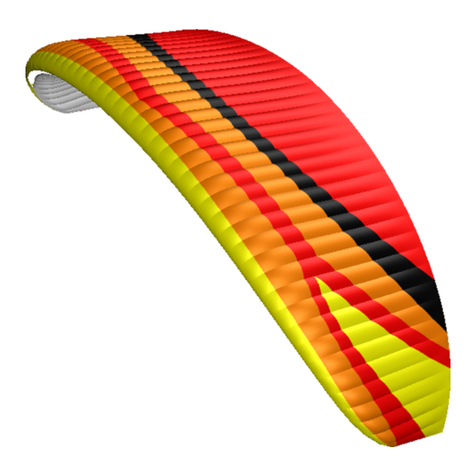
Dudek
Dudek Universal 1.1 25.5 user manual

Gin
Gin Boomerang12 user manual

Daher
Daher TBM 700 Pilot's manual

Cosmik Aviation
Cosmik Aviation EV-97 teamEUROSTAR UK Pilot operating handbook
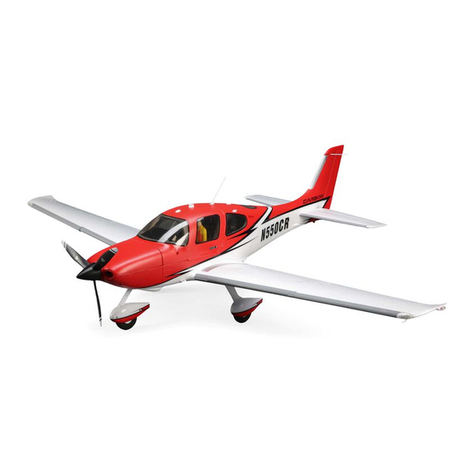
Horizon Hobby
Horizon Hobby Cirrus SR22T instruction manual

